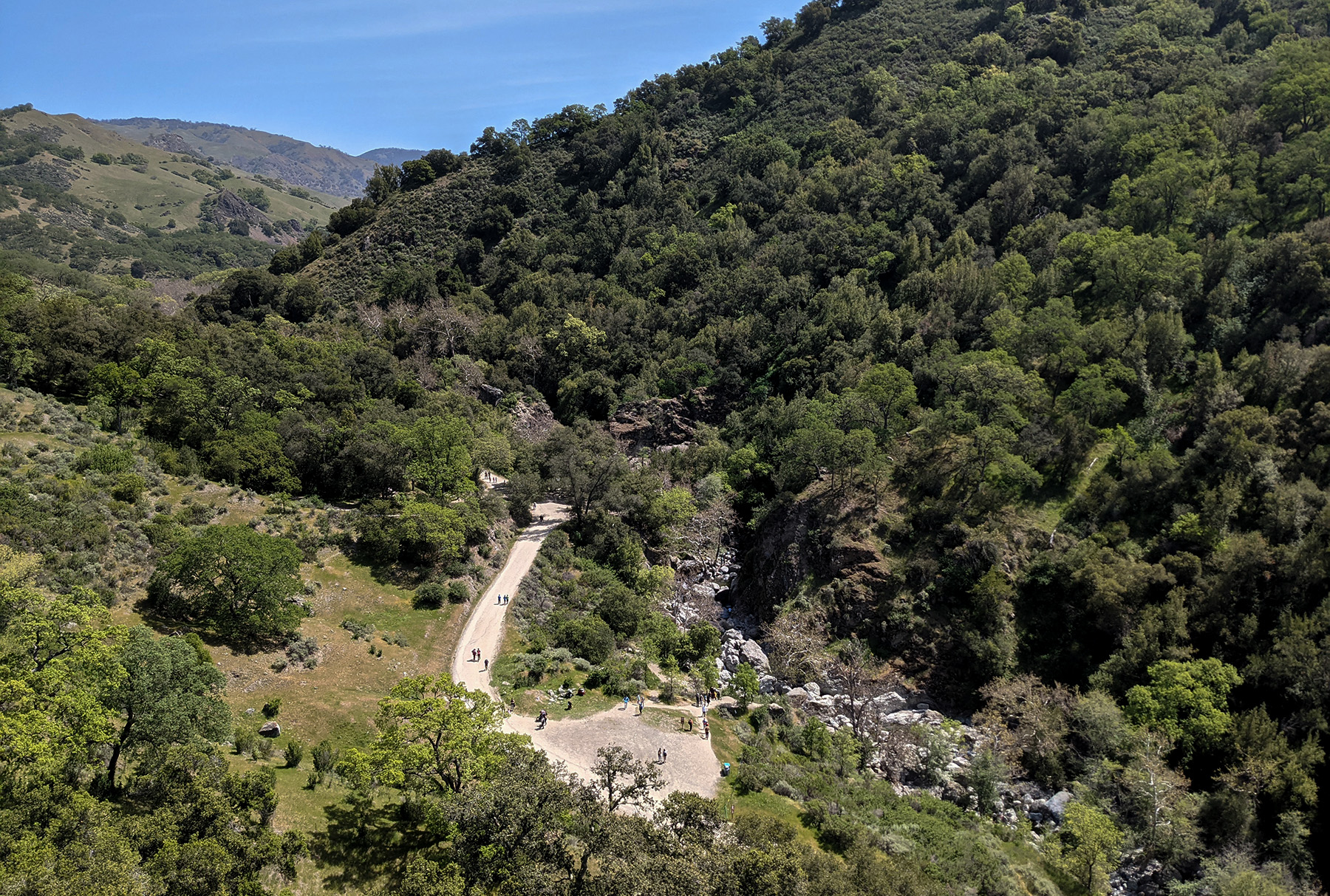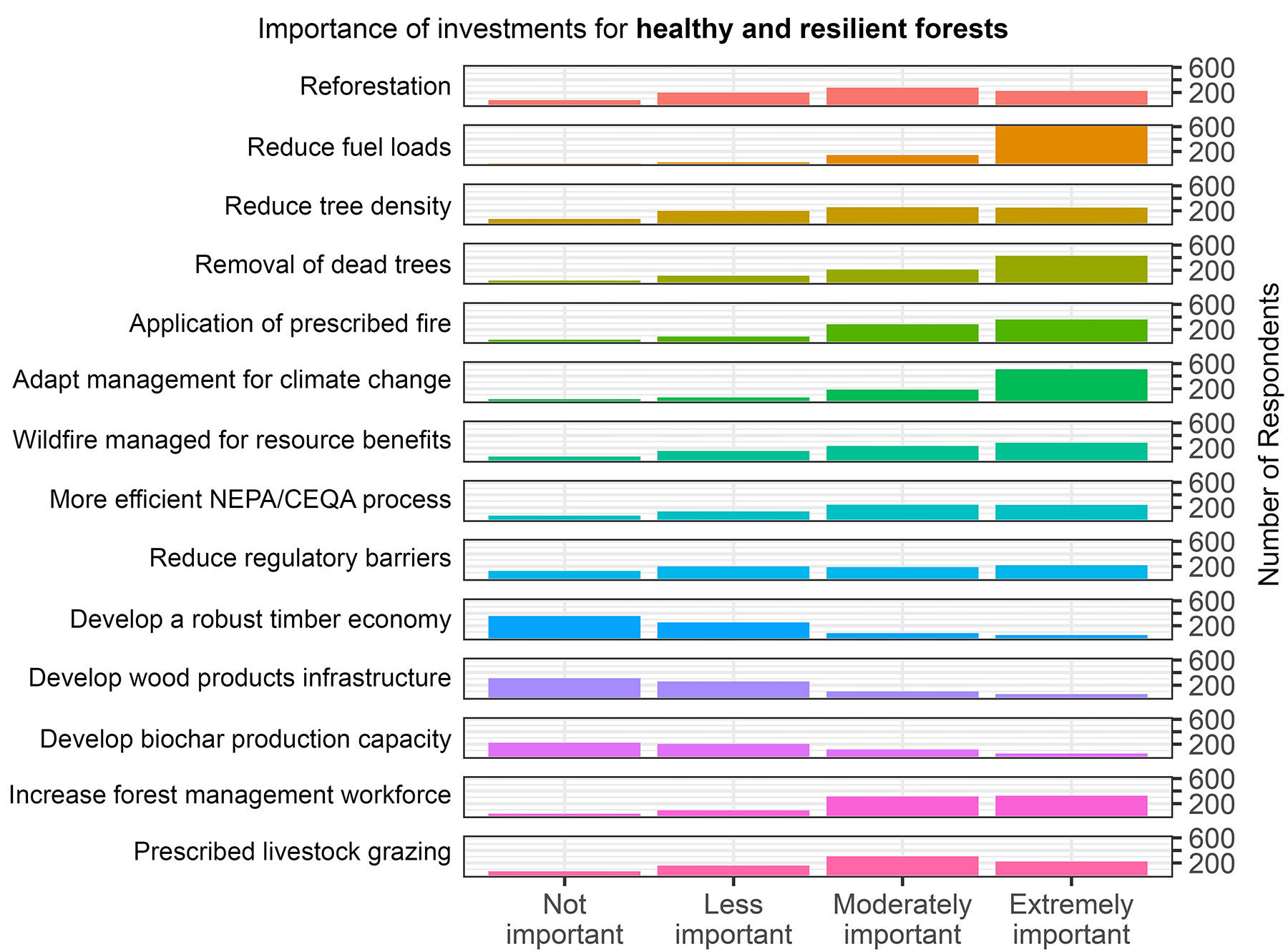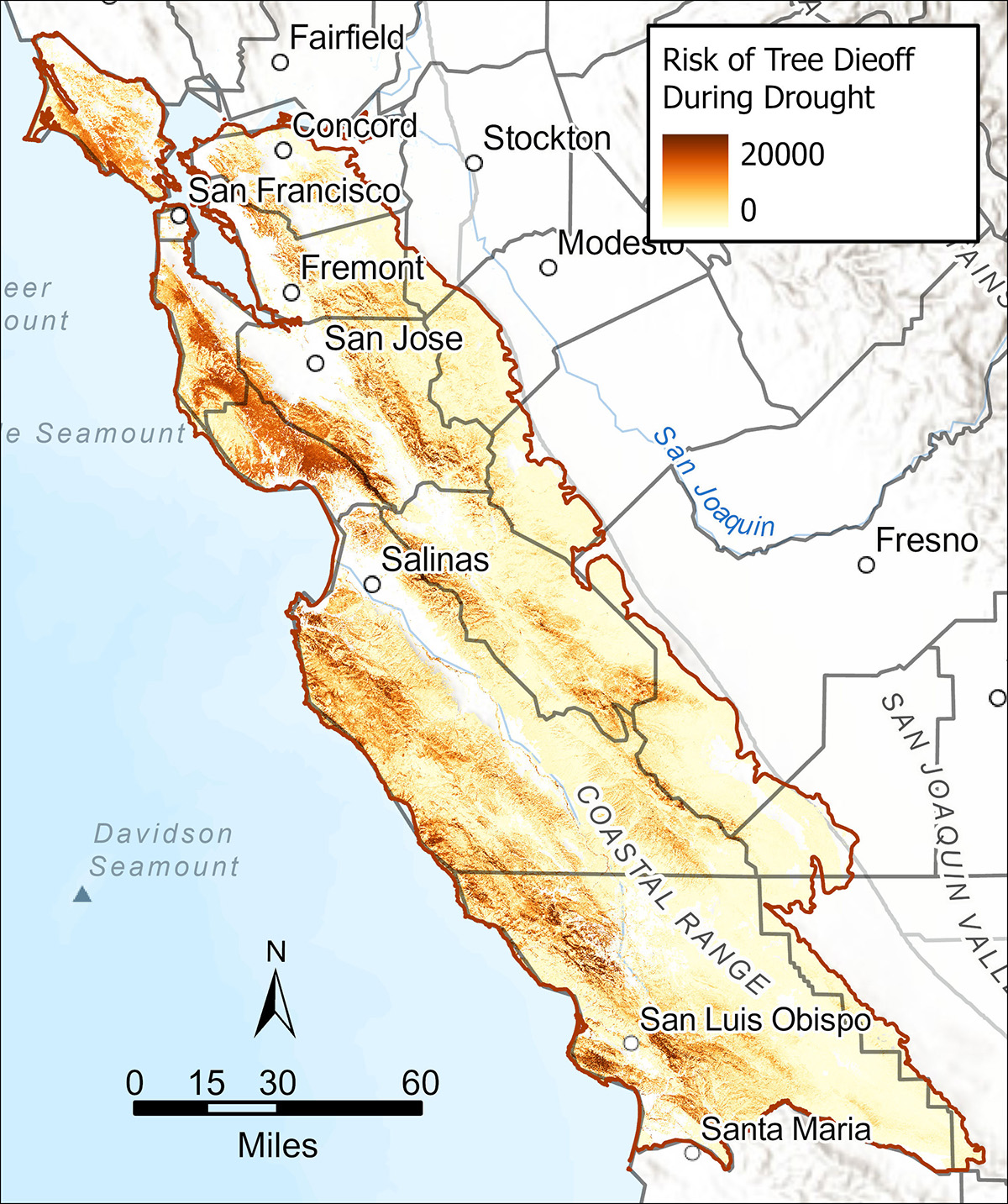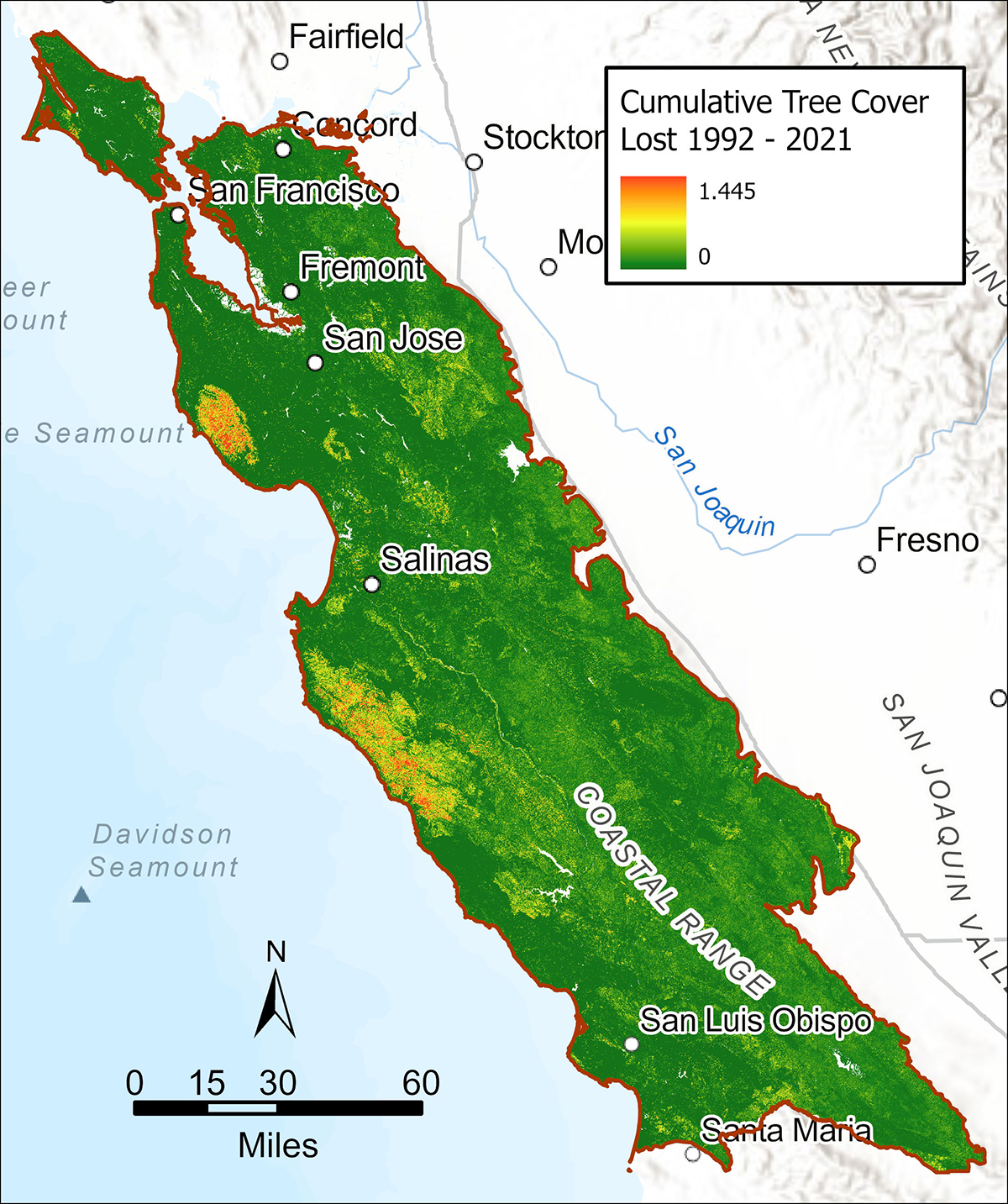Central Coast Regional Profile
HEALTHY & RESILIENT FORESTS

photo credit: Chelsea Andreozzi
Overview
Forests and woodlands make up a quarter of the land cover of the Central Coast region and provide vital ecosystem services, including protecting the health of key water sources, sequestering carbon, and offering recreational opportunities. Managers are challenged to respond to multiple threats to these ecosystems, including climate change, invasive species, novel pathogens, development of natural lands, and changing wildfire regimes. Threats and management priorities vary by forest type.
Oak Woodlands
Oak woodlands are a culturally and ecologically important ecosystem of the Central Coast. For thousands of years they have provided resources to human communities and have served as important wildlife habitat. Oak woodlands primarily occupy foothills and valleys in the region, and they are dominated by one or more oak tree species with an herbaceous or shrub understory. The most common species in the region are blue oak, coast live oak, and valley oak. Each species has different evolutionary adaptations to its environment. For example, as its name implies, coast live oak is better adapted to coastal conditions than other oak trees; in fact, 80% of California’s coast live oak woodland is found in the Central Coast region.
For at least 3,000 years, ancestral land managers used frequent fire to manage oak woodlands for resource benefits, such as improving acorn crops and stimulating the growth of plants used for weaving baskets. Oak woodlands are adapted to this high-frequency, low-intensity fire regime, which benefit oak trees over competing species, such as shrubs and conifers. This stewardship ended in the 19th century when European colonization displaced Indigenous peoples and outlawed cultural burning. However, ranchers also burned oak woodlands to increase forage production for livestock until mid-20th century fire suppression policies prohibited burning. Decades of fire suppression and a decline in grazing have led to increased tree density, encroachment by shrubs and conifer species, and a more homogenous fuel landscape that can sustain higher intensity fire over larger areas. The introduction of invasive grasses has further stressed these systems as they outcompete native species, diminish ecosystem services, and are often more flammable than the native species they replace. These conditions further increase the risk of larger, more severe fires occurring.
Central Coast oak woodlands are also threatened by emerging diseases, pests, and climate change. Sudden oak death (SOD) is an infectious disease caused by the water mold Phytophthora ramorum, which has killed millions of tanoaks and oak trees, primarily coast live oak, in coastal California forests since the late 1990s. Significant tree mortality has also been caused by recent severe droughts. Tree mortality increases surface fuel loads and numbers of standing dead trees (snags) on the landscape. Management actions that restore low-severity fire back into these systems, reduce fuel loads, and remove invasive species will increase the resilience of oak woodlands to future climate change, invasive species, and novel pathogens.
Coast Redwood Forests
Coast redwood forests are an iconic ecosystem of the Central Coast that are increasingly vulnerable to emerging threats. Coast redwoods persist in a narrow band along the California coast, reaching the southern limit of their range in Monterey County. Coast redwood trees and many other plants in this highly-specialized ecosystem are adapted to absorb fog water through their leaves, and fog water sustains these forests during the dry summer months. If fog frequency declines in the future due to climate change and urban heat island effects, redwood forests may be increasingly drought stressed.
Coast redwood trees are adapted to both low and high-intensity fire. Their thick bark protects living tissue, and they have the capacity to resprout from their truck even after wildfire consumes their crowns. These trees can live for over 2,000 years and grow over 320 ft tall, making them the tallest trees in the world. However, few of these ancient trees still exist because redwood is one of the most valuable trees for timber. Over 95% of the existing California coast redwood ecosystem has been logged at least once, and younger forests are denser and more homogeneous than mature forests.
The prevalence of sudden oak death (SOD) is an emerging threat to the coast redwood ecosystem. Although coast redwood trees are not susceptible to the pathogen, they frequently co-occur with tanoak trees which have suffered as high as 90-100% mortality in some impacted areas. Dead tanoak trees alter fuel loads and can increase the risk of higher-severity fire because fire can move from the surface to the canopy by using the standing dead trees as a ladder. A study of the 2008 Basin Fire in Big Sur, Monterey County found that standing, disease-killed tanoaks caused crown fires and significantly contributed to elevated redwood mortality from the fire.
The largest surviving stands of old-growth redwoods on the Central Coast are found in Big Basin Redwoods State Park (Big Basin), which is also notable for being California’s oldest state park. In August 2020, the CZU Lightning Complex fire burned across 86,509 acres of forest lands in San Mateo and Santa Cruz Counties, including burning more than 97% of Big Basin, at much higher severity than historically occurred. This fire was followed by two years of extreme drought, which further stressed the surviving trees. This has raised concerns that even ancient forests are under significant threat from the compounding threats of climate change and fuel accumulation.
Regional organizations such as Save the Redwoods League and Sempervirens Fund are leading efforts to restore the health of redwood ecosystems and to adapt redwood forests to climate change and other emerging threats. Management actions in this ecosystem include applying prescribed fire to reduce fuels; thinning dense, young forests to encourage the growth of mature habitat characteristics; and protecting properties that might serve as important climate refugia for redwoods and associated species in the future.
Mixed Hardwood-Conifer Forests
Various other hardwood and conifer tree species also occur in the Central Coast region, including serotinous (closed cone) pine species, such as Monterey pine, bishop pine, and knobcone pine. These species are highly adapted to a low-frequency, high-intensity fire regime because they depend on the heat of a fire to remove competition, open their cones, and release their seeds. Historically, lightning-ignited fires occurred on the Central Coast every 50 to 100 or more years in these forests and provided this necessary disturbance. If fire occurs too frequently then these species do not have sufficient time to mature and develop their canopy seed bank, which is critical for post-fire recovery. The years following fire are a critical period for these ecosystems as the seedlings need suitable moisture to regenerate. Extended droughts can lead to regeneration failure, and the area may transition to a different habitat type.
Stakeholder Perspectives

Survey respondents considered the top priority area of investment for achieving healthy and resilient forests to be reducing fuel loads, followed by adapting management for climate change. Removing dead trees and applying prescribed fire were also on average rated highly, followed by increasing forest management workforce. Developing a robust timber economy, wood products industry and biochar capacity were considered on average to be ‘less important.’ However, only 591 of the 784 respondents provided a rating for the question about biochar production, suggesting less public familiarity with that topic.
Interview findings: When asked what the key issues were to achieving ecological resilience in the region, many interviewees detailed concerns about how regional forest and woodland ecosystems were not adapted to modern disturbance regimes. Long-term fire suppression policies that were intended to protect forests from burning up have led to unprecedented levels of fuel accumulation, increasing the risk of a higher intensity fire than regional forests and woodlands are evolutionarily adapted. While many of these ecosystems are adapted to fire, there is an intensity threshold at which fire can kill mature trees and impede ecosystem recovery, and we do not yet know what the long-term impacts of those high-intensity fires will be. Interviewees perceived that there was also a persisting tendency to apply knowledge and models established in other systems of California to the Central Coast region, and there is a need to better understand fuel management approaches should be applied to habitat such as oak woodlands and redwood forests. Regional forests and woodlands are also showing signs of increasing mortality and stress due to climate-driven changes, and there is a need to anticipate how species will be affected to adaptively manage for the future.
Resource Conditions


Risk of tree dieoff during drought (top) can be used as a metric of forest health and resilience; understanding how this risk varies across the landscape can help managers prioritize actions to reduce density of trees and alleviate moisture stress for remaining trees or to identify likely locations of high dead fuel buildup from dieoff. This metric is presented as a dimensionless index ranging from 0 to ~20,000. Low values indicate minimal risk of dieoff during drought, because there are few trees in the pixel and or there is ample local moisture even during periods of drought. High values indicate significant risk of tree dieoff during drought, as a result of both a high density of trees at the site and insufficient local moisture. In the Central Coast, eastern Santa Cruz and San Mateo Counties have dense areas with a high risk of tree dieoff during drought; patches of high risk are also found down the coast of Monterey and San Luis Obispo Counties. The RRK also includes data on cumulative tree cover loss (bottom) from fires, management, and dieoff. This metric is measured as an absolute value, ranging from 0 to 1; though values can exceed 1 if multiple disturbances occurred.
